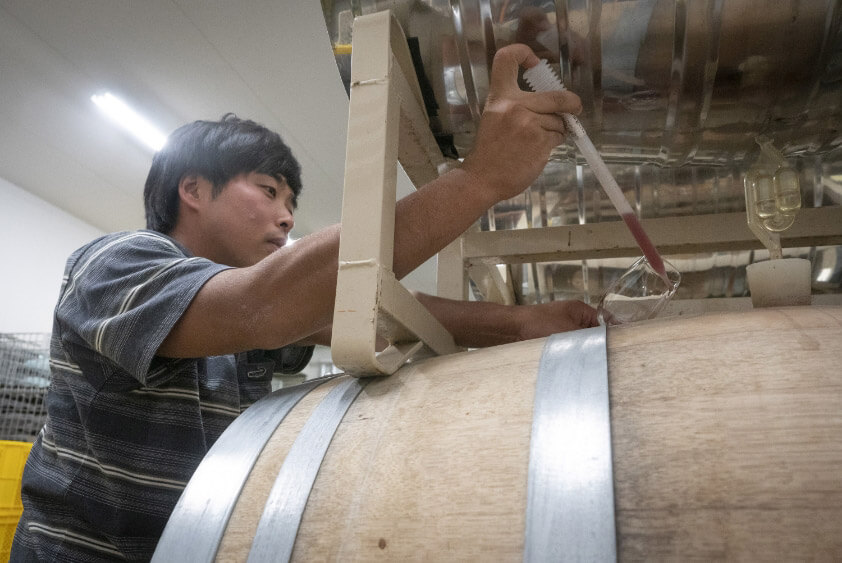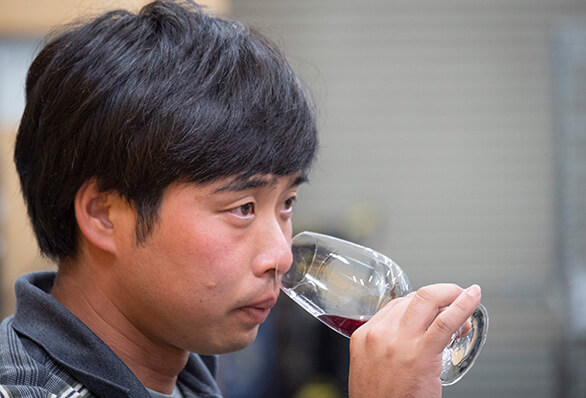Winery
Iyobe met Kondo
The first wine making was trial and error for both of us.
- Yoshie Iyobe
- President of Sapporo Fujino Winery
- Ryosuke Kondo(President of kondo vineyard)
- Director of Sapporo Fujino Winery
Iyobe
An indispensable person in our winemaking process is Mr. Ryosuke Kondo (current president of kondo vineyard). Without Mr. Kondo, Fujino Winery would not be what it is today. I met him at a small winery where I was learning to make wine. He helped me by consulting with me about my desire to make my own wine. In 2009, we made our first wine in a small, cramped winery. After trying both red and white wines, I said to myself, “Oh, my God, it’s done!” I’ll never forget that moment and how impressed I was.
Do you remember the small plant on main street?
Kondo
Of course. It was a very small place.
Iyobe
We applied for the winemaking license and built the equipment at the same time, and got the license in 2009, just before the first wine was made. The grapes we used were traditional Campbell and Niagara. I used to love eating these grapes. We were newcomers and couldn’t afford wine grapes.
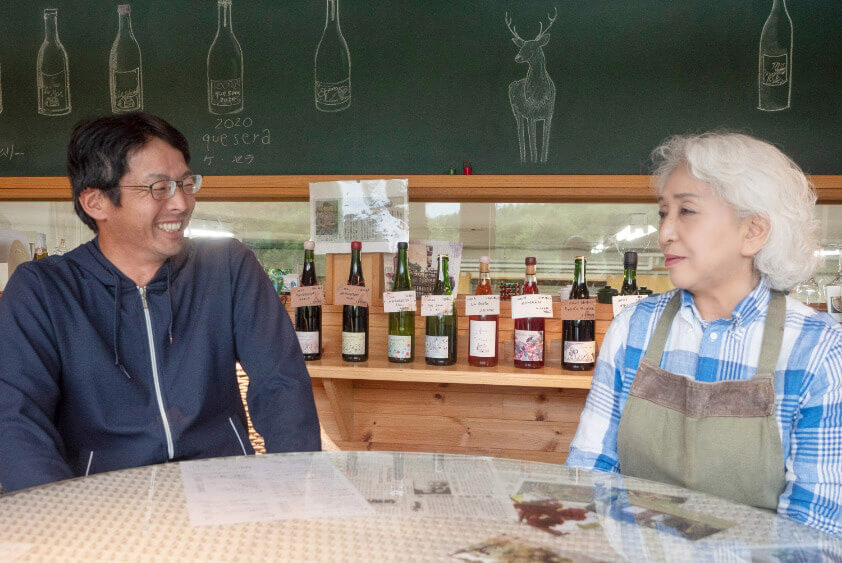
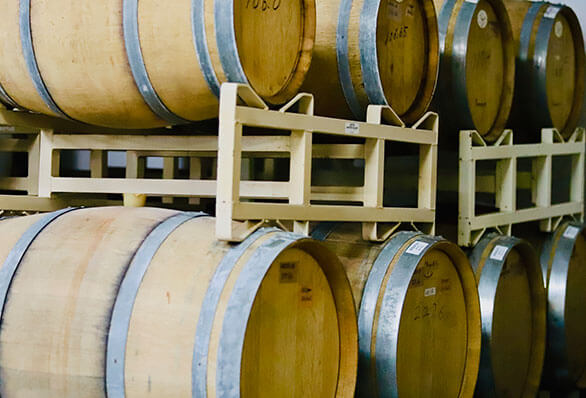
Kondo
Now I have my own winery, but at that time we were both still exploring. We weren’t always interested in wine itself to begin with.
Iyobe
I loved grapes, but I wasn’t interested in wine. I guess I first became interested in it when I traveled to Europe and saw a stone-built wine chateau and thought, “What a wonderful place this is!”
Kondo
I wasn’t always interested in wine either.
Iyobe
We were both studying winemaking. I first met Kondo-san at a winery where I was studying.
Kondo
That’s right. When I was in college, I had not found what I wanted to do. I vaguely wanted to be involved in agriculture, and the first job I found was agricultural training as an employee of Utashinai City. Before going to Utashinai, I spent a year training at a grape farm in Yoichi. There, I cultivated grapes for wine, which was my first experience. Until then, I had never even drunk wine. In 2006, I participated in a training program in France, which strengthened my desire to make wine by myself.
Iyobe
At first, you came to our place to help us while building your own farm.
Kondo
I started cultivating my own land in Mikasa in 2007. I had no money and no idea what the future would bring. At that time, I was very lucky to be allowed to work at Fujino Winery. I was going back and forth between Fujino and Mikasa, but I don’t know what I would be doing now if I hadn’t had that chance. …… (laughs).
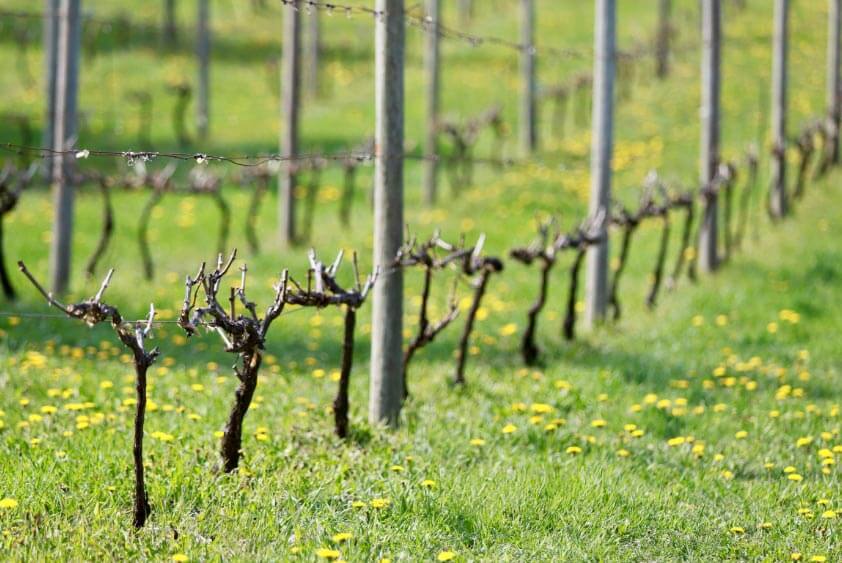
Iyobe
The first year of 2009 was like a test vinification. Even so, I will never forget the excitement I felt when the first wine was made.
Kondo
This was the first time I was involved in every aspect of the winemaking process, and in retrospect, I feel like an amateur in some ways, but I thought the wine was delicious.
Iyobe
We started working in earnest in the second year. In 2010, the climate was good, and we were able to obtain excellent Chardonnay and Merlot grapes from Otobe Town.
Kondo
We also got some wonderful Niagara and Campbell from Yoichi. We were able to make really good wines. The natural sparkling Niagara we made at that time received very good reviews. I think it was an unusual method at the time. Even though it is Niagara, it is not sweet. It was dry. It was something new to consumers.
Iyobe
Making wine from grapes for fresh eating was not very popular, and it became a hit product. Even though we did not advertise it, customers from all over the country heard about it and demanded it.
Kondo
To tell the truth, it takes skill and equipment to ferment sweet grapes and keep them sweet. The lack of such technology and equipment has inevitably resulted in dry wines.
Iybe
Dry wine is the best match for the dishes. Maybe that’s what was good about it. We often talked about what kind of wine we should make.
Kondo
When I saw the grapes I had picked, I thought about what to do with them. I look at the ingredients and think about what kind of wine I can make from that. It is like cooking. We did not want to use sulfurous acid as a preservative, and we did not want to filter the grapes, so we shared the basic policy of wanting to keep the wine as natural as possible.
Iyobe
It is so-called “vin nature,” which you have always insisted on. I had a younger brother who was sick, so I thought it would be good if I could make wine that was good for him.
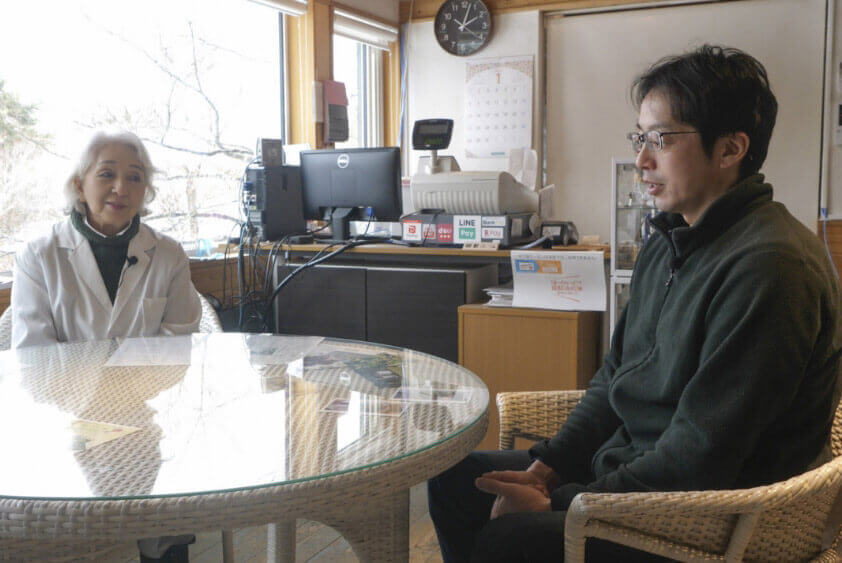
Kondo
The definition of “vin nature” is also difficult, but one thing I can say for sure is that we do not use cultured yeast. This is a prerequisite. We do not use excessive amounts of sulfurous acid to prevent oxidation. Sulfurous acid stabilizes the quality of the wine and is a necessary measure if you want to distribute the wine on a large scale, but I think it is not necessary if the wine is sold on a small scale and within reach. In Japan, there are no regulations for “vin nature” or “natural” wines, so I can’t really explain it clearly.
Iyobe
At that time, you hardly heard the word “vin nature”. In 2015 we moved the winemaking plant to its current location.
Kondo
By that time, my Mikasa vineyard had grown a lot of grapes, and it was time for me to start my own business. But somehow, I ended up continuing to be involved in the project (laughs).
Iyobe
No, it was because I asked to stay. Because I thought it would be impossible without you. I really wanted to be consulted at the timing of various decisions.
Kondo
Then came Uramoto (Tadayuki Uramoto), who can be called my “apprentice”. He is now the main person in charge of winemaking.
Iyobe
It was when he was still a student at Hokkaido University. He looked like a boy, and I offered him a glass of wine at a wine tasting event. I told him to say stop if he wanted, but he didn’t. (laughs) Then one day he called me and said, “I want to study wine.
Kondo
Both you and I tried hard to persuade him that he should quit such a difficult and unprofitable job (laughs). But he still didn’t give up. He ended up going to France for about six months, and then came back and studied at my place while he was still a university student. He didn’t quit easily (laugh), so I thought, “Oh, he’s going to do it.” After graduating from university, I asked him to get involved in the project.
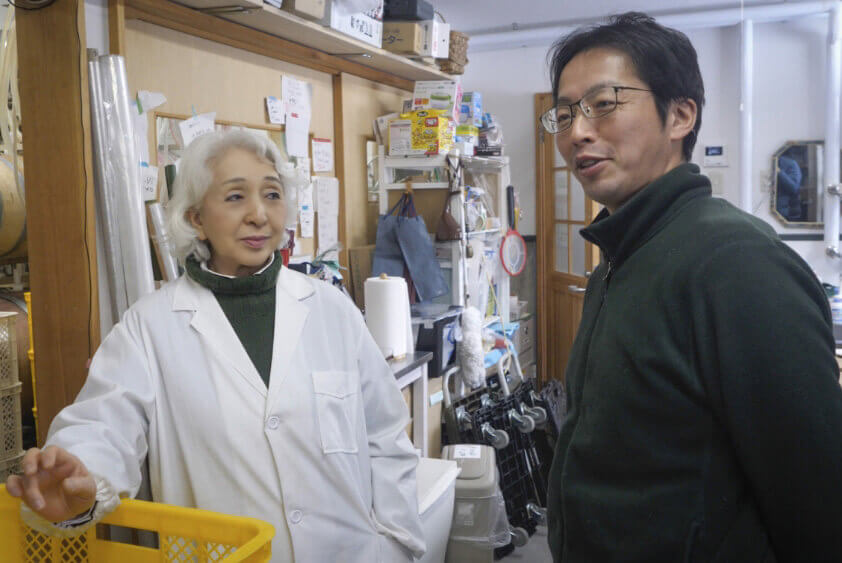
Iyobe
Uramoto is also planning to go independent in the future, but he has become an indispensable part of our winery. Both you and Uramoto make gentle wines. Gentle wines that anyone would love. Neither you nor I have the constitution to drink that much alcohol, but we can taste wines. The grapes are different every year, so we can’t make the same wine, but I think that’s fine.
Kondo
Grapes are the most important part of wine making. When you make wine, you also want to make grapes.
Iyobe
Fujino Winery uses less than 10% of its own grapes. We buy the rest from reliable farmers.
Kondo
Wine grapes are delicious to eat, aren’t they?
Iyobe
Oh, really? I think Chardonnay and Pinot are good, but I still prefer Niagara and Campbell’s for eating. I prefer the old-fashioned grapes to the trendy Shine Muscat.
Kondo
I prefer wine grapes because they taste richer when I eat them. You really, really like grapes, don’t you?
Iyobe
I still eat it often. I love it!
Kondo
Now that Uramoto has joined us, I am less involved in the Fujino site and can concentrate on my own field.
Iyobe
I liked the way you made your wine. Gentle, flavorful, mellow. It shows character. Someone should inherit this taste. Please keep watching over us.
Kondo
Yes, it’s my pleasure.
